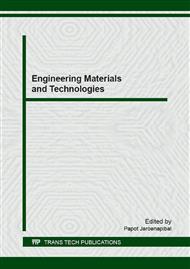[1]
T. Desmet, R. Morent, G.N. De, C. Leys, E. Schacht, Dubruel, Nonthermal plasma technology as a versatile strategy for polymeric biomaterials surface modification: a review, Biomolecules, 10 (2009) 2351-2378.
DOI: 10.1021/bm900186s
Google Scholar
[2]
M. Roy, S.K. Meena, T.S. Kusurkar S.K. Singh, N.K. Sethy, K. Bhargava, S. Sarkar, M. Das, Carbondioxide gating in silk cocoon, Biointerphases, (2012) 7-11.
DOI: 10.1007/s13758-012-0045-7
Google Scholar
[3]
F. Chen, F. Vollrath, D. Porter, Structure and physical properties of silkworm cocoons, J R Soc Interfac. 9 (2012) 2299-2308.
DOI: 10.1098/rsif.2011.0887
Google Scholar
[4]
J. Zhang, R. Rajkhowa, J.L. Li, X.Y. Liu, X.G. Wang, Silkworm cocoon as natural material and structure for thermal insulation, Mater. Design. 49 (2013) 842 – 849.
DOI: 10.1016/j.matdes.2013.02.006
Google Scholar
[5]
N.P.C. Horrocks, F. Vollrath, C. Dicko, The silkmoth cocoon as humidity trap and waterproof barrier, Comp Biochem Phys A. 164 (2013) 645 – 652.
DOI: 10.1016/j.cbpa.2013.01.023
Google Scholar
[6]
L. Cabrales, N. Abidi, Microwave plasma induced grafting of oleic acid on cotton fabric surfaces, Appl Surf Sci. 258 (2012) 4636-4641.
DOI: 10.1016/j.apsusc.2011.12.130
Google Scholar
[7]
S. Photong, V. Boonamnuayvitaya, Preparation and characterization of amine-functionalized sio2/tio2 films for formaldehyde degradation, Appl Surf Sci. 255 (2009) 9311 – 9315.
DOI: 10.1016/j.apsusc.2009.07.021
Google Scholar
[8]
R. Molina, J.P. Espinós, F. Yubero , P. Erra, E A.R. González, XPS analysis of down stream plasma treated wool: Influence of the nature of the gas on the surface modification of wool, Appl Surf Sci. 252 (2005) 1417 – 1429.
DOI: 10.1016/j.apsusc.2005.02.147
Google Scholar
[9]
G. Borcia, C.A. Anderson, N.M.D. Brown, Surface treatment of natural and synthetic textiles using a dielectric barrier discharge, Surf Coat Tech. 201 (2006) 3074 – 3081.
DOI: 10.1016/j.surfcoat.2006.06.021
Google Scholar
[10]
G. Li, H. Liu, T. Li, J. Wang, Surface modification and functionalization of silk fibroin fibers/fabric toward high performance applications, Mater Sci Eng. 32 (2012) 627 – 636.
DOI: 10.1016/j.msec.2011.12.013
Google Scholar
[11]
S. Photong, V. Boonamnuayvitaya, Enhancement of formaldehyde degradation by amine functionalized silica/titania films, J Environ Sci. 21 (2009) 1741–1746.
DOI: 10.1016/s1001-0742(08)62482-1
Google Scholar
[12]
S.S. Banerjee, M.V. Joshi, R.V. Jayaram, Treatment of oil spill by sorption technique using fatty acid grafted sawdust, Chemosphere. 64 (2006) 1026–1031.
DOI: 10.1016/j.chemosphere.2006.01.065
Google Scholar
[13]
G. Socrates, Infrared and Raman Characteristic Group Frequencies: Tables and Charts 3rd ed. Chichester: John Wiley and sons, (2001).
DOI: 10.1002/jrs.1238
Google Scholar


